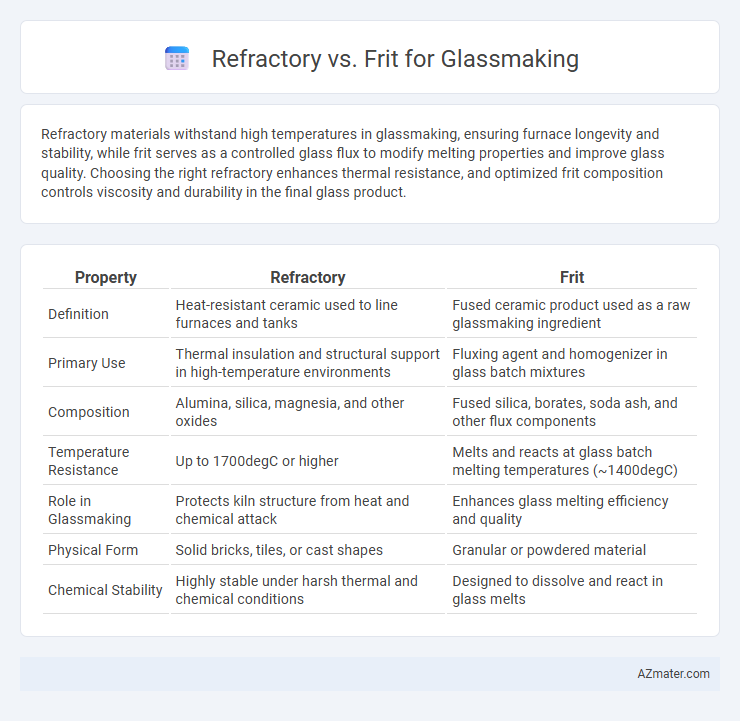Refractory materials withstand high temperatures in glassmaking, ensuring furnace longevity and stability, while frit serves as a controlled glass flux to modify melting properties and improve glass quality. Choosing the right refractory enhances thermal resistance, and optimized frit composition controls viscosity and durability in the final glass product.
Table of Comparison
| Property | Refractory | Frit |
|---|---|---|
| Definition | Heat-resistant ceramic used to line furnaces and tanks | Fused ceramic product used as a raw glassmaking ingredient |
| Primary Use | Thermal insulation and structural support in high-temperature environments | Fluxing agent and homogenizer in glass batch mixtures |
| Composition | Alumina, silica, magnesia, and other oxides | Fused silica, borates, soda ash, and other flux components |
| Temperature Resistance | Up to 1700degC or higher | Melts and reacts at glass batch melting temperatures (~1400degC) |
| Role in Glassmaking | Protects kiln structure from heat and chemical attack | Enhances glass melting efficiency and quality |
| Physical Form | Solid bricks, tiles, or cast shapes | Granular or powdered material |
| Chemical Stability | Highly stable under harsh thermal and chemical conditions | Designed to dissolve and react in glass melts |
Introduction to Glassmaking Materials
Refractory materials and frits are essential components in glassmaking, each serving distinct roles in the manufacturing process. Refractories provide structural support and withstand high temperatures within glass furnaces, ensuring durability and heat resistance during melting. Frits, composed of pre-melted raw materials cooled rapidly, enhance glass batch homogeneity and control melting characteristics, directly impacting the final glass quality and uniformity.
What Are Refractories in Glass Production?
Refractories in glass production are heat-resistant materials used to line furnaces, melters, and other equipment exposed to extreme temperatures during glassmaking. These materials, often composed of alumina, silica, and fireclay, maintain structural integrity and prevent contamination in the molten glass. High-quality refractories ensure consistent melting conditions and extend furnace lifespan, directly impacting glass quality and production efficiency.
Understanding Frits in Glass Manufacturing
Frits in glass manufacturing are partially fused materials that serve as a crucial intermediate in glass production, offering enhanced homogeneity and reactivity compared to raw raw materials. Refractories, conversely, are heat-resistant materials used to line furnaces and contain molten glass, providing thermal stability and protection during the melting process. Understanding frits involves recognizing their role in improving glass quality by optimizing melting duration, composition, and reducing defects in the final product.
Chemical Composition: Refractory vs Frit
Refractory materials in glassmaking primarily consist of high-alumina or silica-based compounds designed to withstand extreme temperatures without melting or deforming. Frits, on the other hand, are pre-melted mixtures of raw materials like silica, soda ash, and limestone that have been rapidly cooled to form a stable glassy phase, allowing precise control over chemical composition and melting behavior. The distinct chemical compositions of refractories, rich in oxides such as alumina (Al2O3) and silica (SiO2), contrast with the flux-rich, amorphous nature of frits engineered to lower melting points and improve batch homogenization.
Functional Roles in Glassmaking
Refractories serve as heat-resistant materials that contain and protect glass melts during high-temperature processes, ensuring structural integrity in furnaces and kilns. Frit acts as a pre-melted, partially fused glass concentrate that improves melting efficiency, controls viscosity, and enhances the chemical composition of the final glass product. Together, refractories facilitate thermal stability while frits optimize melting characteristics and glass quality in manufacturing.
Thermal Stability and Performance
Refractory materials in glassmaking offer superior thermal stability, maintaining integrity at temperatures exceeding 1500degC, which prevents deformation and contamination during molten glass processing. Frits, composed primarily of partially melted raw materials, provide controlled melting points around 1000-1400degC, ensuring better glass composition homogeneity but with lower thermal resistance. The choice between refractory and frit depends on the required thermal performance and product quality, with refractories being ideal for high-temperature furnace linings and frits enhancing glass batch melting efficiency.
Manufacturing Processes Compared
Refractories used in glassmaking are high-temperature resistant materials that form the furnace lining, ensuring durability and thermal stability during molten glass processing. Frit, a glassy material produced by melting raw materials at high temperatures, serves as a key raw ingredient in glass manufacture, influencing melting behavior and final glass properties. The manufacturing process of refractories involves sintering fireclay or alumina-based compounds for structural integrity, whereas frit production entails controlled melting and quenching to create uniform, easy-to-melt granules essential for consistent glass formation.
Applications in Glass Industry
Refractories are crucial for glass furnaces, providing thermal stability and resistance to chemical corrosion during high-temperature glass melting processes. Frits, composed of pre-melted and rapidly cooled glasses, serve as raw materials or additives to modify glass composition and enhance properties like durability and color uniformity. In the glass industry, refractories ensure furnace longevity and process efficiency, while frits optimize glass quality and performance across applications such as container, flat, and specialty glass manufacturing.
Advantages and Limitations
Refractories in glassmaking offer superior thermal stability and resistance to chemical corrosion, essential for maintaining furnace integrity under high temperatures. Frits, composed of pre-melted glass, provide uniform composition and reduced melting times, enhancing production efficiency and product consistency. However, refractories can be costly and prone to wear over time, while frits may introduce impurities or alter viscosity if not precisely formulated.
Choosing Between Refractory and Frit
Choosing between refractory and frit in glassmaking depends on the desired thermal stability and chemical composition of the final product. Refractories offer superior resistance to high temperatures and mechanical wear, making them ideal for furnace linings and heavy-duty applications, while frit provides controlled melting characteristics and enhanced homogeneity for glass batch formulations. Optimal selection hinges on balancing thermal durability with melting behavior to achieve efficiency and quality in glass production.

Infographic: Refractory vs Frit for Glassmaking
 azmater.com
azmater.com